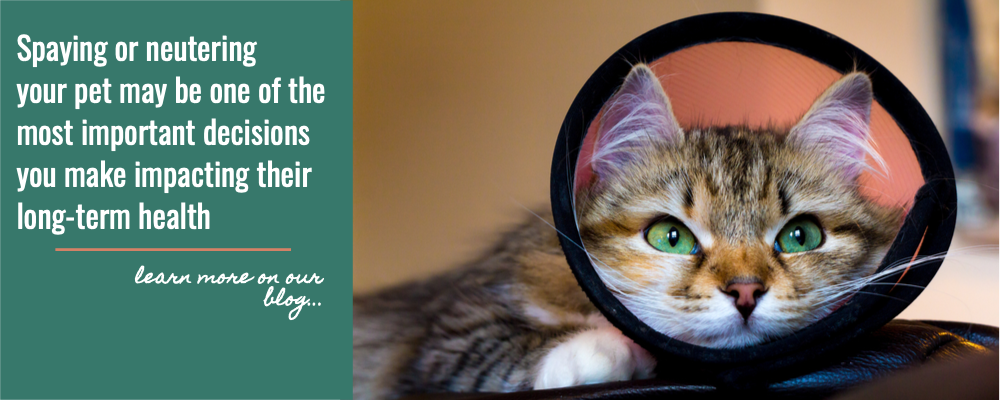The choice to spay or neuter your pet may be one of the most important decisions you make impacting their long-term health—and your wallet!
There are medical and behavioral benefits to spaying (female pets) and neutering (male pets) your animals.
Here are some of the medical benefits:
Your female pet will live a longer, healthier life. Spaying helps prevent uterine infections and breast tumors, which are malignant or cancerous in about 50 percent of dogs and 90 percent of cats. Spaying your pet before her first heat offers the best protection from these diseases.
Neutering your male companion prevents testicular cancer and some prostate problems.
And behavioral benefits:
Your spayed female pet won’t go into heat. While cycles can vary, female felines usually go into heat four to five days every three weeks during breeding season. In an effort to advertise for mates, they’ll yowl and urinate more frequently—sometimes all over the house!
Your male dog will be less likely to roam away from home. An intact male will do just about anything to find a mate, including finding creative ways escape from the house. Once he’s free to roam, he risks injury in traffic and fights with other male animals.
Your neutered male may be better behaved. Unneutered dogs and cats are more likely to mark their territory by spraying strong-smelling urine all over the house. Your dog might be less likely to mount other dogs, people and inanimate objects after he’s neutered. Some aggression problems may be avoided by early neutering.
Spaying/neutering your pets is also highly cost-effective. The cost of your pet’s spay/neuter surgery is far less than the cost of having and caring for a litter.
Debunking Spay/Neuter Myths and Misconceptions
Spaying or neutering will not cause your pet to become overweight. Lack of exercise and overfeeding will cause your pet to pack on the extra pounds—not neutering. Your pet will remain fit and trim as long as you continue to provide exercise and monitor her food intake.
Neutering is not a quick fix for all behavior problems. Although neutering your pet often reduces undesirable behaviors caused by a higher level of testosterone, there’s no guarantee that your dog’s behavior will change after he’s neutered. Although the surgery will reduce the amount of testosterone in your dog’s system, it won’t eliminate the hormone completely. Neutering will also not reduce behaviors that your pet has learned or that have become habitual. The effects of neutering are largely dependent on your dog’s individual personality, physiology and history.
Helping Your Pet Before and After Surgery
Avoid giving your pet any food after midnight the night before surgery. Water can be left out until you leave the house.
Your veterinarian will provide post-operative instructions for you to follow. Although your pet may experience some discomfort after surgery, medication for pain will be sent home with your pet.
Provide your pet with a quiet place to recover indoors and away from other animals.
Prevent your pet from running and jumping for as long as your veterinarian recommends.
Prevent your pet from licking the incision site, which may cause infection, by distracting your pet or by using an Elizabethan collar.
Avoid bathing your pet for at least ten days after surgery.
Check the incision site daily to confirm proper healing.
If you notice excessive redness, swelling or discharge at the surgery site, or if the incision is open, please contact your veterinarian. Also call your veterinarian if your pet is lethargic, is vomiting or has diarrhea or any other concerns following surgery.
What is the right time to spay or neuter my pet?
Small breed dogs (<45lbs estimated adult weight)
- Female – spay at 7 months
- Male – Castration at 9 months
Large and medium breed dogs (45+lbs) – doctors will discuss the timing of the surgery.
There are some benefits to waiting until a year of age in larger breed dogs:
- Conformational differences (in dogs refers solely to the externally visible details of a dog’s structure and appearance, as defined in detail by each dog breed‘s written breed standard.)
- Less joint problems
- Golden Retriever FEMALE only – reduced incidence of cancer (except breast)
What are the disadvantages of waiting until a year?
- Increased risk of breast cancer (3%-8%)
- Possibility of unwanted pregnancy
- Male Behavior Problems
- Females having heat cycles
Cats – “Fix at Six” is the rule. Males can be neutered and females spayed at 6 months of age.
